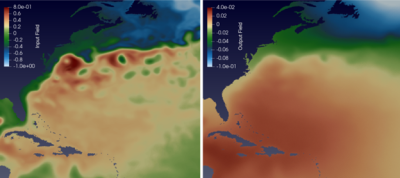Improving Tidal Modeling with Self-Attraction and Loading
When the mass of water in a location fluctuates due to tides, it deforms the Earth's crust, changing the gravitational potential of the Earth and ocean. Accounting for this effect, known as self-attraction and loading (SAL), is necessary to accurately model tides. However, the high computational cost means SAL is often approximated using a simple and less accurate scalar multiple of the sea-surface height. Researchers demonstrate a method of calculating SAL that is computationally feasible and reduces the tidal error compared to approximation methods. By calculating SAL at defined intervals rather than at every time step, they increased model accuracy without dramatically increasing computational cost.
Changes in tides are one of the many impacts expected to affect coastal regions over the next century due to climate change. In order to better predict future tides, researchers are adding SAL forcing into the Model for Prediction Across Scales-Ocean (MPAS-Ocean), the ocean component of the Department of Energy’s Energy Exascale Earth System Model. This work is focused on implementing a computationally efficient, but still accurate, method of including the SAL term. This will enable future explorations on how tides interact with other parts of the earth system, such as ice shelves or estuaries.
To accurately model tides, it is important to include SAL forcing. Tidal-related mass loading leads to deformations in the Earth's crust and changes to the gravitational potential of the deformed Earth and ocean. Current computationally efficient methods commonly use a scalar approximation to calculate SAL, but a more accurate method involves using costly spherical harmonic decompositions. Researchers implemented the more accurate method using fast spherical harmonic transforms in MPAS-Ocean. They showed further improvement in computational efficiency without sacrificing accuracy by updating SAL in intervals of 10–30 minutes rather than at every time step. The results also show that using a variable resolution mesh with increased resolution around regions that are shallow and regions where the ocean floor topography is steep can also improve tidal accuracy at a lower computational cost than using a uniform high-resolution mesh. The new SAL method reduced tidal error by 40 percent when compared to the scalar approximation for a variable resolution mesh.

